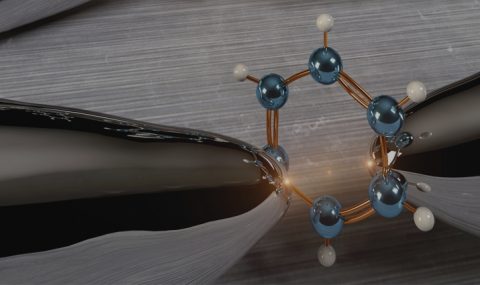Our lab is equipped with break junction setups at cryogenic temperature. We use various measurement techniques to thoroughly analyze the structural and transport properties of our atomic scale conductors. In particular, we measure conductance, inelastic electron spectroscopy, shot noise, anisotropic\spin-valve magnetoresistance, and thermopower.
The Break Junction Technique
Our method of choice for the formation of atomic and molecular junctions is the mechanically controllable break junction technique. In a break junction setup, a metal wire or a thin metal strip with a narrow part at the center is attached to a flexible and insulating substrate. This structure is placed in a vacuum chamber, which is pumped and cooled to 4.2K. The wire is broken by controlled bending of its supporting substrate to expose two fresh and clean electrode apexes in cryogenic vacuum conditions.
The inter-electrode separation can be adjusted in picometer resolution to form an atomic junction, in which one atom or a chain of atoms is left suspended between the two electrodes, or alternatively, allow the introduction of molecules as a bridge between the electrode apexes. Electron transport measurements on an ensemble of different junction configurations can be collected by repeatedly breaking and reforming the junction.
Our break-junction setups are specially designed for in-situ chemical manipulations. The setups include a heated molecular source for introducing purified molecules into the cold junction. The in-situ formation of our atomic and molecular junctions at 4.2K provides the following advantages: (1) formation of ultra-clean electrode apexes with undercoordinated surface atoms that are highly reactive (made of metals as Ni, Pt, Al, Ag, Au); (2) avoiding the use of solvents to prevent possible passivation or uncontrolled modifications of the electrode apexes by the solvent molecules or accompanying contaminations; and (3) the freedom to use a large variety of molecules that either decompose (e.g., oxygen) or chemically react with the undercoordinated atoms at the electrode tips to form metal-molecule hybrid systems that can be further controlled by changing the molecule orientation or atomic spacing.
Schematic illustration of the working principle of a break junction technique. Following the breaking of the metal wire, two fresh electrode tips are exposed in cryogenic vacuum conditions. Molecules are introduced in between the two tips by in-situ sublimation from a local molecular source. The distance between the two electrode tips can be adjusted in sub-angstrom resolution.
Shot noise analysis
Current shot noise refers to time-dependent current fluctuations due to the discreteness of electrons. In junctions, these fluctuations arise from the quantum mechanical probability of electrons being transmitted or reflected from the junction. As a result, the noise generated by the junction depends on the conductance contributions of the different conduction channels across the junction constriction (in the framework of Landauer formalism). The conduction channels originate from the confinement of the current in the junction constriction, and the number of channels in an atomic scale junction is related to the local orbital structure. For example, the current across Au atomic junctions is carried by a single conduction channel, which is dominated by the gold s valance orbital. In contrast, for Ni atomic junction, more channels participate in the conductance due to additional d valance orbitals that are available for transport in the direction of the current.
Based on shot noise and conductance measurements, the number of conductance channels and the conductance contribution of each channel can be determined. However, we cannot provide the exact channel conductance for more than two channels, as dictated by using only two equations for noise and conductance. We overcome this limitation by relaxing the requirement for exact identification of the conductance of each channel, and we numerically identify the range of possible conductance contributions for each individual channel (R. Vardimon at al. Phys. Rev. B 88, 161404R (2013)). Using this approach significant information can be gained despite its finite uncertainty. For example, we could decompose conductance oscillations observed during the formation of Pt atomic chains to their channel components to study their orbital origin (R. Vardimon et al. Nano Lett. 14, 2988 (2014)) and recently, we probed the evolution of spin conduction channels during the formation of nickel oxide atomic junction (R. Vardimon et al. Nano Lett. 15, 3894 (2015)).
Furthermore, the removal of spin degeneracy can be detected by measuring noise values that penetrate a forbidden range of conductance and noise for spin-degenerate channels, while a minimal boundary for the degree of current spin polarization can also be extracted. Shot noise can also provide useful information about electron correlations, for example, in Kondo systems.

Schematics of an atomic scale constriction in a conductor. When the diameter of the constriction approaches the electronic Fermi wavelength, the electrons are quantized in the transverse direction. As a result, only certain propagating electron modes (conduction channels) can be transmitted through the constriction.
Magnetoresistance measurements
Magnetoresistance is the response of electrical resistance to magnetic field manipulations. Our sample design is optimized to efficiently suppress unwanted magneto-elastic electrode movements. For spin-valve experiments, we developed an asymmetric electrodes structure (Fig. 1c, inset) that allows us to magnetize the electrodes in parallel or antiparallel configurations. Our cryogenic setups are equipped with either a 9Tesla magnet or a 3Tesla-9Tesla vector magnet that provides a variable magnetic field along a particular axis for magnetoresistance measurements in a spin-valve configuration or a 360° rotating magnetic field for anisotropic magnetoresistance measurements.

Asymmetric nickel electrodes (marked in red) for spin-valve experiments in atomic-scale junctions. The side electrodes (marked in gray) are used to monitor changes in the magnetization of each electrode separately.



